CLEAN ENERGY FROM SPACE
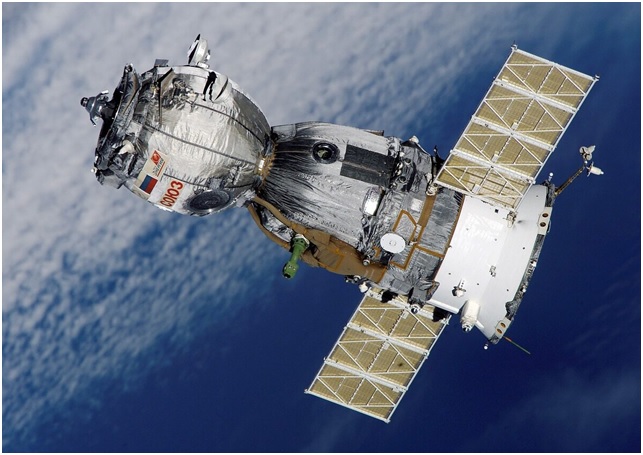
Just think, it is now one step away from being possible. Pull up the lever on your home’s electrical panel, and it connects with a ray of energy coming from the sun and bounced off a satellite: no cost, no ecological damage, no end. An existing network of satellites can prevent blackouts. When the planet turns, and it is night, our homes, transport and heating systems use the electricity stored during the day. No cables underground, no waste to dispose of…
Without energy, life on the planet is impossible. Plants and animals have complex systems of transforming sun and food into energy, without which they cannot exist. Humanity has in the meantime discovered ways to use energy far beyond what a single human body can produce. The forms of energy and the methods of using it have come a long way: from using the muscle power of man himself, and then domesticated animals, to obtaining energy from various sources and managing the flow of energy. World energy consumption is increasing every year, as energy systems are the engine of social and economic development and energy is essential for all aspects of human well-being.
But as the energy demand curve continues to rise to levels unthinkable just a quarter of a century ago, having accepted that our planet’s resources are finite and that fossil fuels will soon be exhausted, humanity is developing alternative ways of generating energy using renewable energy resources such as wind, water, solar, geothermal and tidal power[1] . Energy production is at the heart of the global climate problem, as most greenhouse gases are generated by burning fossil fuels. Coal, oil and gas are major contributors to global climate change, being responsible for 75 per cent of global greenhouse gas emissions and almost 90 per cent of all carbon dioxide emissions[2] . But we are caught between a rock and a hard place: we need more and more energy, and we must stop using energy that poisons the ecosystem, otherwise we will soon wipe life off the planet.
The energy of the sun
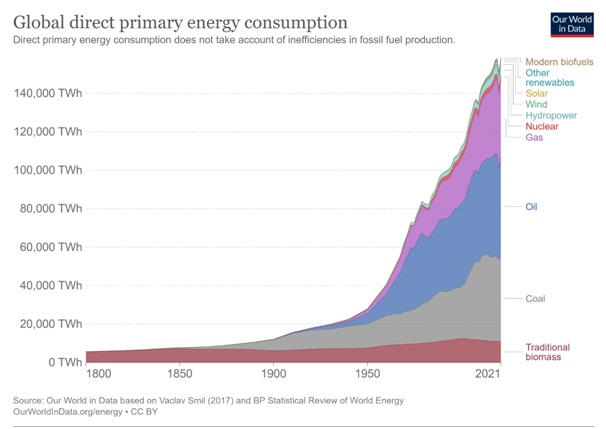
Global energy consumption[3]
Solar energy has been used for a long time and everywhere, and solar panels have long been in common use. But this technology is not perfect. Besides the high cost of the components, the complexity of installation and the low power density, the biggest problem is the Earth’s atmosphere, as the molecules in our atmosphere disperse about half of the sunlight. Moreover, due to variable weather conditions and the resulting variability of the sun’s rays, this type of energy rarely serves as a permanent source[4] . But what about getting that energy beyond the atmosphere? Space-based solar power makes it possible to harness the sun’s virtually unlimited energy reserves in space, where it is constantly available and independent of day and night cycles, seasons and weather conditions, potentially increasing efficiency by a factor of eight compared to solar panels on the earth’s surface[5] .
The California Institute of Technology has launched the Space Solar Power Project (SSPP), which aims to collect solar power in space and transmit it to the earth’s surface. As part of this project, the pioneering MAPLE (Microwave Array for Power-Transfer Low-orbit Experiment) experiment a few weeks ago demonstrated for the first time that wireless transmission of solar power from space to Earth is possible with the technology we already have available. Space Solar Power is a revolutionary solution that can harness unlimited solar energy via solar satellites[6] .
SSPD-1, the Space Solar Power Demonstrator, was the first space prototype of this project. It is a complex and innovative project comprising three experiments: MAPLE, DOLCE and ALBA. MAPLE (Microwave Array for Power-Transfer Low-orbit Experiment) focuses on the wireless transmission of power, while DOLCE aims to demonstrate the architecture and deployment mechanisms of modular spacecraft: an ultra-light composite structure that deploys in a manner similar to a 2 metre diameter sail. Although the sail does not contain solar cells, its purpose is to test the thin, flexible and large deployment that will be required to build a future power plant[7] . And ALBA – designed to evaluate the effectiveness of various photovoltaic cells under harsh space conditions – is testing 32 solar cell samples[8] . A further fourth component of the SSPD is the electronics unit, which communicates with the spacecraft’s computer and monitors and controls the three experiments.[9]
A 50-kilogram solar energy space demonstrator was launched into space in January this year by the Momentus Vigoride spacecraft, installed aboard a SpaceX rocket as part of the Transporter-6 mission. Once in orbit, it deployed experimental photovoltaic panels designed to harvest solar energy in a vacuum[10] . MAPLE is equipped with a microwave transmitter, which in turn is a system of 32 antennas grouped in clusters of 16. Each cluster is controlled by a single, customised, flexible integrated circuit chip made from low-cost silicon technology. At a distance of approximately 30 cm from the transmitter are two receivers, called arrays, which are independent systems of signal receivers.
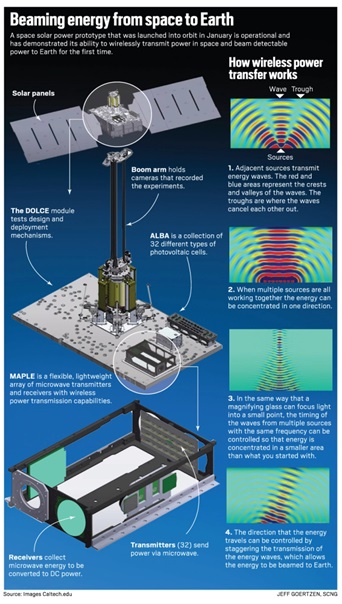
The Maple principle of wireless power transmission[11]
The solar energy collected by the photovoltaic cells is converted into electrical waves by the transmitter and transmitted to signal receivers, which in turn convert the microwaves into direct electrical current and launch it with millimetre precision to storage sites on earth[12] . This principle of wireless energy transmission through space is based on a quantum phenomenon called ‘interference’.
This interference is observed when two or more waves overlap. Depending on the phase relationship between the waves, they can either amplify (constructive interference) or weaken (destructive interference). When two waves meet in phase, their amplitudes add up and constructive interference occurs. In this case, an amplification of the waves is observed and the areas where the amplitudes add up are called interference maxima[13] .
Put simply, this effect can be observed if you create waves with your hands immersed in water: there are areas where the wave is stronger, and areas where the wave diverges. However, if we imagine that there are two or more sources and that they create waves in a coordinated manner, i.e. simultaneously and in the same direction, with the same phase, then the waves will concentrate in one direction and compensate in all other directions and their peak at their meeting will create a peak of greater height. This phenomenon makes it possible to realise the ‘magnifying glass’ principle, in which the flow of energy from several sources can be concentrated and coordinated in the desired direction[14] . From the sun directly into our kitchens.
Using this principle, scientists at the California Institute of Technology demonstrated the efficiency of transmitting energy from one microwave transmitter to each of two receivers by changing the focus and direction of the emitted energy. The transmitter array uses precise timing controls to dynamically and selectively focus the energy at the right point, adding electromagnetic waves. This allows most of the focused energy to be transmitted in the chosen direction over the earth, without disturbance from the atmosphere.
By precisely controlling the timing of this process, the direction of the energy can be adjusted very quickly (nanoseconds) and the energy can be redirected to space receivers or even receivers on Earth. Together, this allows the energy to be directed to the right place and nowhere else, without the need for mechanical moving parts[15] . Two receiver arrays converted solar energy into direct current, which was used to power a pair of LED lights, demonstrating the complete wireless energy transfer sequence. MAPLE successfully demonstrated this by turning on each individual LED and switching between them[16] .
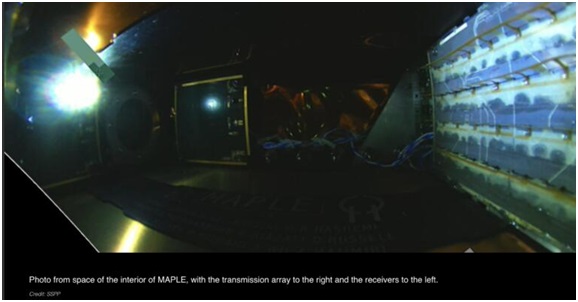
On the right is a transmitter and on the left two receivers, with a round window between them to transmit energy outside the prototype[17]
This demonstrates not only the possibility of transmitting solar energy from orbit to Earth, but also of transmitting it between spacecraft[18] . Furthermore, the unsealed experiment took place under difficult space conditions, including temperature fluctuations, solar radiation and irradiation, demonstrating the robustness of the system and its ability to function under such conditions.
MAPLE also has a small window through which the prototype can transmit energy. The energy transmission was detected by a receiver on the roof of the Gordon and Betty Moore Engineering Laboratory on the campus of the California Institute of Technology in Pasadena on 22 May 2023. The received signal appeared at the predicted time and frequency based on its journey from orbit[19] . Unfortunately, data on the power transmitted from space to Earth have not been published[20] .
The entire flexible MAPLE array, as well as its main wireless power transmission electronics chips and transmission elements, were designed specifically for this project[21] . According to the scientists, the power transmission arrays should be as light as possible to minimise the amount of fuel needed to send them into space, flexible so that they can be folded into a package that can be transported in a rocket and then successfully deployed, and in general should be a low-cost technology[22] . The entire series of three prototypes within the SSPD was conceived, designed, built and tested by a team of about 35 people[23] .
Prospects for a revolutionary technology
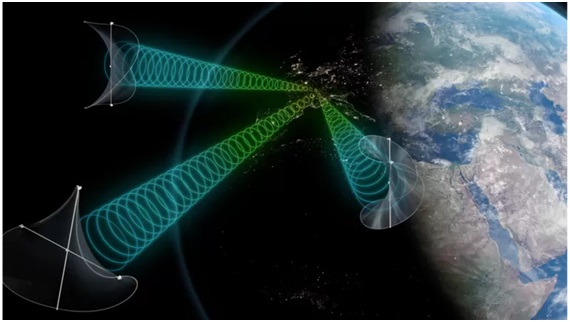
European Space Agency’s Solaris project involves wirelessly pumping gigawatts from space[24]
“Just as the Internet has made information available to everyone, we hope that wireless power transmission will simplify access to energy,” said Ali Hajimiri, head of the Space Solar Power Project (SSPP). ‘There is no need for any infrastructure to transport this energy to Earth. This means we can send energy to remote regions and areas devastated by wars or natural disasters,”[25] .
Despite the weakness of the transmitted signal, which was only 200 milliwatts (less than the light of a phone camera)[26] , this was enough to demonstrate what the system could perfom if produced on an industrial scale[27] . The development team is currently evaluating and analysing the individual components of MAPLE, a process that could take up to six months and provide a good basis for avoiding the pitfalls of implementing a large-scale space energy system in the future. It is expected that the SSPP will consist of a constellation of modular spacecraft using solar panels similar to sails[28] , capable of collecting sunlight in space and, converting it into electricity, emitting it in the form of microwaves at great distances[29] .
In theory, space energy has existed since the 1970s and many countries are engaged in a ‘race’ for clean solar energy. A group of scientists from Kyoto University, in collaboration with the Japanese space agency JAXA, plans to conduct an experiment to effectively transmit energy from space to Earth around 2025. The plan is not for the scientists to prove that the transfer is scientifically possible, but to put it into practice. To do so, they will launch small satellites to send solar energy to ground receiver stations[30] . The success of such a project is important for China in the context of international prestige in the field of space energy and the consequent possibility of cooperation with other states[31] . The start-up Virtus Solis Technologies[32] is also working on energy transmission and plans to launch a pilot plant into orbit in 2026, with the intention of offering commercial energy to customers by the end of the decade[33] .
A huge incentive for the development of space energy in the European Union is the 2050 Net Zero objective, a long-term national strategy to create a zero greenhouse gas emission economy with the goal of keeping the global temperature increase well below 2°[34] . The European Space Agency is working to find funding[35] to prove that a solar-powered satellite system is commercially feasible[36] . The registration of a sufficiently sophisticated and functional patent would be enough to trigger the enthusiasm of the authorities in Brussels, so under pressure due to the war in Ukraine.
It’s not that simple
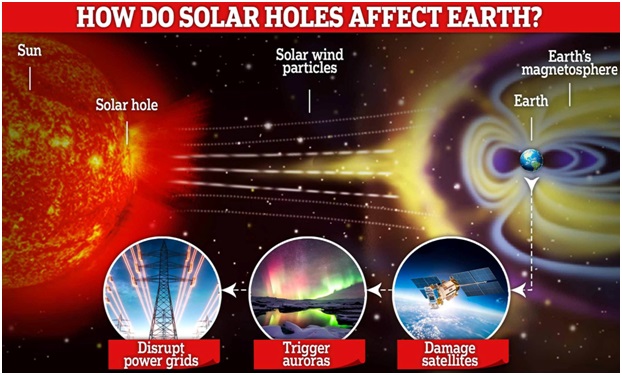
The dangerous effects of the sun on the earth[37]
According to the United Nations Group of Experts on Climate Change, the world is currently on track to warm by 2.5 degrees Celsius by the end of the century, or 1 degree Celsius above the threshold that the scientific community considers safe to avoid catastrophic consequences[38] . To contain warming, the global economy will have to reduce its greenhouse gas emissions by 45% by 2030, which means that many fossil-fuel consuming technologies will have to be phased out in a very short period of time. In this context, the search for reliable alternative energy sources becomes imperative and scientists predict that solar energy will dominate the energy landscape of the future.
There are no scientific difficulties to be solved in the process of ‘extracting’ space energy; the theoretical foundations have been worked out and the physics behind the processes demonstrated. The MAPLE experiment has shown that remote energy transfer is possible both in space and from orbit to Earth. The question rather concerns the scale of energy transfer, which is directly related to the level of technological readiness of the individual industry receiving[39] .
In addition, space energy requires a huge financial investment: the California Institute of Technology project cost more than $112 million[40] . With global energy costs amounting to trillions of euros, it is estimated that the first one-gigawatt solar-powered satellite will cost around 20 billion euros, comparable to building a new nuclear power plant. But thanks to mass production and economies of scale, subsequent satellites could significantly reduce construction and operating costs. Consequently, the cost of generating a basic level of electricity from satellites would be more than half that of nuclear power plants and about the same as that of large ground-based solar power plants[41] . But in the context of space power, this is an investment in the future with no satisfactory alternative.
Given the enormous power capacity of solar energy, comparable to that of nuclear power plants, apart from the issue of energy harvesting and transmission, the problem of energy storage remains unsolved. In this context, the question becomes: what do we expect from cosmic energy in the future: a backup alternative or the main source of energy for our planet?
For the time being, a mission to extract energy from space has the noble purpose of providing energy to remote and inaccessible areas where connection to traditional energy networks may be difficult or impossible. This can be particularly useful for developing countries and remote areas, as well as areas prone to destruction. Space is for everyone, the sun is for everyone, but in the future of space energy development, the issue of legal regulation and distribution of this resource, as well as the question of security, may become acute.
Although the transition to renewable energy is crucial for the future of the world and the concept of space-based solar energy is very exciting and promising, it is important to maintain a healthy scepticism about it. As with all scientific advances, the true potential of this technology will only be revealed with further development and testing[42] . In any case, the technology demonstrated by the California Institute of Technology team represents an important milestone and paves the way for more advanced space systems. And then we will see!
USA026
[1] https://trends.rbc.ru/trends/green/609e76449a7947f4755ac9dc
[2] https://www.un.org/en/climatechange/raising-ambition/renewable-energy
[3] https://ourworldindata.org/grapher/global-primary-energy?time=earliest..latest
[4] https://www.theguardian.com/science/2022/oct/09/beam-me-down-can-solar-power-from-space-help-solve-our-energy-needs
[5] https://www.caltech.edu/about/news/in-a-first-caltechs-space-solar-power-demonstrator-wirelessly-transmits-power-in-space
[6] https://www.intelligentliving.co/space-based-solar-energy-caltechs-sspd-1-successfully-demonstrates-wireless-power-transmission/
[7] https://www.science.org/content/article/satellite-beams-solar-power-down-earth-first-kind-demonstration
[8] https://www.intelligentliving.co/space-based-solar-energy-caltechs-sspd-1-successfully-demonstrates-wireless-power-transmission/
[9] https://knowridge.com/2023/01/caltech-will-launch-space-solar-power-technology-demo-into-orbit/
[10] https://24tv.ua/tech/ru/osushhestvlena-pervaja-uspeshnaja-peredacha-solnechnoj-jenergii-iz-kosmosa-na-zemlju-tehno_n2328064
[11] https://www.pasadenastarnews.com/2023/06/07/caltech-researchers-show-power-can-be-wirelessly-transmitted-in-space-the-implications-are-huge/
[12] https://www.science.org/content/article/satellite-beams-solar-power-down-earth-first-kind-demonstration
[13] https://portal.tpu.ru/SHARED/t/TVERD/Education/Phys3/lecture7_part3_tverd.pdf
[14] https://www.youtube.com/watch?v=w5SBF48WqV4
[15] https://www.space.com/space-solar-power-satellite-beams-energy-1st-time
[16] https://www.sciencealert.com/scientists-beam-solar-power-from-space-to-earth-in-world-first
[17] https://www.nextbigfuture.com/2023/06/caltech-demonstrates-space-based-solar.html
[18] https://universemagazine.com/ru/uchenye-vpervye-peredali-na-zemlyu-energiyu-iz-kosmosa/
[19] https://www.caltech.edu/about/news/in-a-first-caltechs-space-solar-power-demonstrator-wirelessly-transmits-power-in-space
[20] https://www.ixbt.com/news/2023/06/04/uchjonym-iz-ssha-vpervye-v-istorii-udalos-peredat-jenergiju-iz-kosmosa-na-zemlju.html
[21] https://knowridge.com/2023/01/caltech-will-launch-space-solar-power-technology-demo-into-orbit/
[22] https://www.caltech.edu/about/news/in-a-first-caltechs-space-solar-power-demonstrator-wirelessly-transmits-power-in-space
[23] https://knowridge.com/2023/01/caltech-will-launch-space-solar-power-technology-demo-into-orbit/
[24] https://www.bbc.com/russian/news-63715834
[25] https://focus.ua/digital/570487-uchenye-peredali-solnechnuyu-energiyu-iz-kosmosa-na-zemlyu-kak-im-eto-udalos-video
[26] https://www.science.org/content/article/satellite-beams-solar-power-down-earth-first-kind-demonstration
[27] https://24tv.ua/tech/ru/osushhestvlena-pervaja-uspeshnaja-peredacha-solnechnoj-jenergii-iz-kosmosa-na-zemlju-tehno_n2328064
[28] https://www.techspot.com/news/98997-caltech-researchers-demonstrate-wireless-solar-power-transmission-space.html
[29] https://www.space.com/space-solar-power-satellite-beams-energy-1st-time
[30] https://focus.ua/digital/569432-energiyu-solnca-budut-sobirat-v-kosmose-i-otpravlyat-na-zemlyu-kak-eto-vozmozhno
[31] https://asia.nikkei.com/Business/Science/Japan-to-try-beaming-solar-power-from-space-in-mid-decade
[32] https://virtussolis.space/
[33] https://www.science.org/content/article/satellite-beams-solar-power-down-earth-first-kind-demonstration
[34] https://climate.ec.europa.eu/eu-action/climate-strategies-targets/2050-long-term-strategy_en#national-strategies
[35] https://www.bbc.com/russian/news-63715834
[36] https://www.theguardian.com/science/2022/oct/09/beam-me-down-can-solar-power-from-space-help-solve-our-energy-needs
[37] https://www.dailymail.co.uk/sciencetech/article-11914637/How-giant-hole-sun-wreak-HAVOC-Earth.html
[38] https://unfccc.int/news/cop27-reaches-breakthrough-agreement-on-new-loss-and-damage-fund-for-vulnerable-countries
[39] https://www.space.com/space-solar-power-pros-cons
[40] https://habr.com/ru/articles/740030/
[41] https://www.esa.int/Enabling_Support/Space_Engineering_Technology/SOLARIS/SBSP_in_support_of_Net_Zero
[42] https://www.electropages.com/blog/2023/06/space-based-solar-power-game-changer-or-just-hype




Leave a Reply